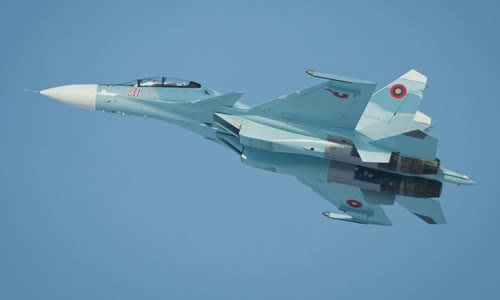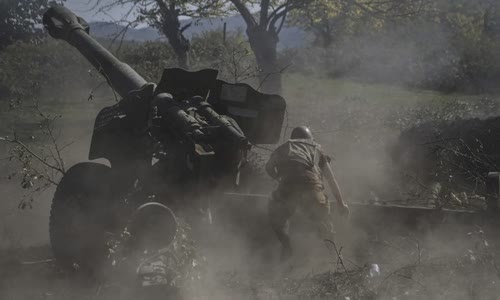Azerbaijan's victory over Armenia at Nagorno-Karabakh not only showed the superiority of technology, but also brought many operational lessons for Europe.
Azerbaijan has continuously modernized its armed forces for the past 10 years, but before the six-week war in Nagorno-Karabakh broke out, not many military experts expected them to achieve such an overwhelming victory first.

Su-30SM fighter before being handed over to Armenia Photo: Avia Press Photo
Azerbaijan's victory mainly stems from its technological and financial advantage, when it can buy modern weapons from Turkey and Israel, far beyond what is on the payroll of Armenia.
This is a modal window.
Beginning of dialog window.
End of dialog window.
The first lesson that the war brings is that the progress of all wars is influenced by the political situation, especially the events that initiated them.
From the outset, Azerbaijan and Turkey were very confident about the success of the military campaign to retake Nagorno-Karabakh, in the context of Russia making it clear that they would not assist Armenia in fighting beyond international borders.
Russia also appears to recognize military pressure from Azerbaijan as a way of undermining the government of Armenian Prime Minister Nikon Pashinyan, who led the movement to change the political apparatus close to Moscow in 2018.
Azerbaijan's military campaign could also force Armenia to accept the Russian-proposed peace plan and strengthen Moscow's geopolitical influence in the region.
Realizing that Russia did not want to participate in the military campaign in Nagorno-Karabakh, Turkey has deployed many multi-purpose fighters F-16 in Azerbaijan since October to serve as deterrent.
For its part, Armenia employs 8 Su-30SM heavy fighters handed over by Russia in 2019, completely outperforming the Azerbaijani air force and ensuring a significant advantage over Turkish F-16s.
General Movses Hakobyan, who resigned as chief of staff of the Armenian army after Yerevan signed an armistice agreement with Baku, criticized the government for purchasing weapons without exploiting their full strength or being inconsistent with reality.
Another reason is that in the contract, Russia requires Armenia not to use the Su-30SM fighter to directly confront Turkey.
The second lesson, according to ECFR experts, is the power of battlefield communications networks and computer systems.
"Many Russian-developed air defense complexes have suffered losses in the wars in Syria and Libya, as well as the conflict in the Nagorno-Karabakh region. This has led many to assume Russia's defensive weapons.
Gressel said the most modern air defense system in Armenian service is four missile units S-300PS and S-300PT-1, along with many mid-range Buk-M1 air defense complexes.
They possess powerful missiles, but the radar system is designed to detect, catch bombers and high-speed fighters, not optimal for small and slow-flying targets like drones.
Their computer systems were set to hardware standards decades ago, while reprogramming required changing nearly all of the system equipment, which Armenia was not able to do.
Armenian air defense grids are also not capable of synthesizing battlefield situations, including collecting and combining data from various radar systems into a unified battlefield picture.

Armenian soldiers shelled Azerbaijan on October 25 Photo: AFP
This feature is very important for detecting UAVs or stealth aircraft.
This explains the huge difference in the defenses of the Russian bases in Syria and Armenia and the air defense systems operated by the two countries.
A Azerbaijan UAV can operate freely because Armenia does not possess the jamming systems enough to suppress the enemy's remote control signal.
General Hakobyan also said that Moscow has fulfilled its obligations to Yerevan, affirming that the Russian electronic warfare system helps the Russian army to disrupt the operation of the UAV Bayraktar TB2 supplied by Turkey to Azerbaijan during 4
However, Azerbaijan's Harop suicide UAV still caused heavy damage to the Armenian forces, when they concentrated in the Nagorno-Karabakh region and did not require control signals from the command post.
"This experience will motivate powers such as the US, Russia, China, Turkey and Israel to study more deeply about artificial intelligence and automatic damage weapons systems.
The third lesson, according to Gressel, is to avoid the opponent's strengths and exploit the weakest areas.
Before the war, the Armenian army had a dominant tactical advantage with its highly experienced officers, soldiers with clear combat goals and agile leadership.
However, in this war, Azerbaijan found a way to overcome Armenian strengths by making the most of the UAVs.
The Azerbaijani UAVs can probe the positions of the Armenian main and reserve forces, then point them to artillery strikes to soften the battlefield and weaken enemy lines.
When the Armenian army is no longer capable of sending reinforcement to the battlefield, Azerbaijani units can deploy at will to encircle and destroy isolated Armenian bases.
This tactic was repeated throughout the war, repelling Armenian soldiers from checkpoints throughout Nagorno-Karabakh, even in mountainous terrain that was supposed to be easy to defend.
The battle at Shusha, the second largest city in Nagorno-Karabakh, showed that the Armenian army had no chance of dealing with Azerbaijan even on the terrain that had their advantage.
Most Western experts when discussing UAVs focus on their technical features.
"Europe should study the lessons from this war carefully, instead of seeing it as just a small conflict between poor countries," Gressel said.
Most European countries have eliminated self-propelled anti-aircraft artillery since the Cold War.
"The vast majority of the European Union's armies, especially the small and medium member states, will suffer pain like Armenia in a modern war. It is a worry," Gressel warned.



 Ladyc Evabless Hayles
Ladyc Evabless Hayles







